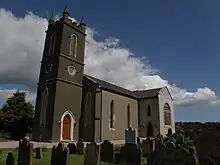Charles Brett
Sir Charles Edward Bainbridge Brett, KBE, CBE (30 October 1928 - 19 December 2005), was a Northern Irish solicitor, journalist, author and founding member, and first chairman, of the Ulster Architectural Heritage Society (UAHS). He was known to many simply as Charlie Brett.
Sir Charles Edward Bainbridge Brett KBE CBE | |
|---|---|
| Born | 30 October 1928 |
| Died | 19 December 2005 Northern Ireland |
| Nationality | British |
| Other names | C.E.B. Brett; Charles E.B. Brett; Charlie Brett |
| Occupation | Solicitor |
| Known for | Irish historic building publications, heritage activism, politics; first chairman of the Ulster Architectural Heritage Society; appointed CBE and KBE |
Early life and education
Brett was born in Holywood, County Down, into a long line of solicitors, the family firm being L'Estrange and Brett, based in Belfast. He was a partner in this firm from 1954 until 1994. He was educated at Aysgarth School, Rugby School and New College, Oxford, where he was President of the Poetry Society and was a friend of Dylan Thomas.[1]
Career
Between 1949 and 1950, he worked in France as a journalist with the Continental Daily Mail, where he is said to have mixed in anarchist and Trotskyite circles.
In 1956, The 8th Earl of Antrim invited Brett to join the Northern Ireland Committee of the National Trust. On finding there were no books written to prepare himself for this, Brett resolved to write the necessary volumes.[2] In 1967, he became the first chairman of the Ulster Architectural Heritage Society (UAHS), founded with, amongst others, Lady Dunleath. Brett served as chairman for ten years and then as President from 1979 until his death.
With the National Trust he put his legal skill to use in order to establish a public footpath along the cliffs of the North Coast of Ulster.
He also sat on the board of the Irish Architectural Archive in Dublin.
Later life
In 1971, he was appointed to the board of the newly created Northern Ireland Housing Executive. He served as Chairman for five years from 1979, during which time 50,000 dwellings were built. He was asked to compile a list of historic buildings in Jersey in 1975. In 1986, Brett became the first chairman of the International Fund for Ireland, established to encourage investment in Ireland.
Brett was also involved in Northern Irish politics, being chairman of the Northern Ireland Labour Party for a time
In 1981 he was appointed a CBE. This was followed by a knighthood, as a KBE, in 1990.

Brett was married and had three sons, and seven grandchildren. His church memorial is located alongside those of his family in the Comber Church of Ireland Parish Church of St. Mary, in Comber, North County Down.

Published works
His volumes, published under the name C.E.B. Brett, included books on the local architecture of the buildings of County Armagh, County Antrim and North County Down. What is perhaps his best known work, Buildings of Belfast, 1700-1914, was originally published by Weidenfeld and Nicolson in London in 1967.
In 1974, the National Trust of Guernsey invited Brett to carry out a similar architectural survey of St Peter Port in Guernsey to mark European Architectural Heritage Year in 1975, resulting in the publication of Buildings in the Town and Parish of St Peter Port. The successful result was repeated for the island of Alderney in 1976, and Saint Helier in Jersey in 1977.
He wrote one satirical volume under the pen name "Albert Rechts", which was an anagram of his name.
He also wrote a volume titled Long Shadows Cast Before , incorporating family history, political commentary and autobiography.
References
- Times Obituary
- "Sir Charles Brett". The Independent. 24 December 2005. Retrieved 23 June 2023.